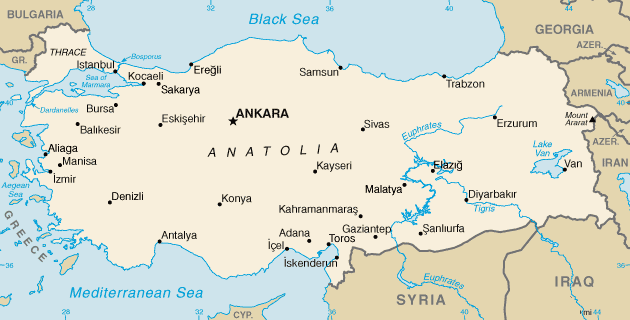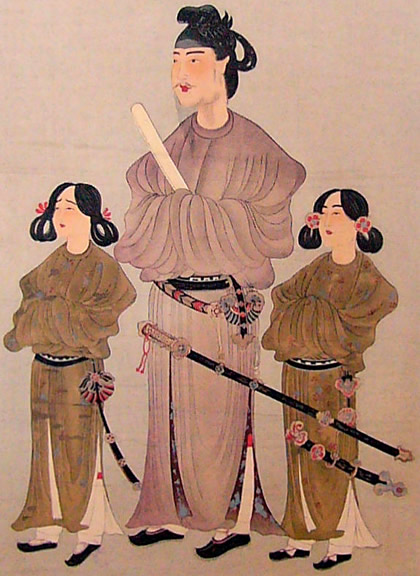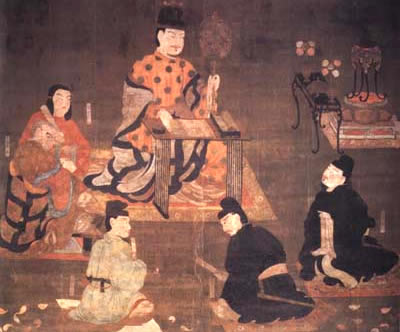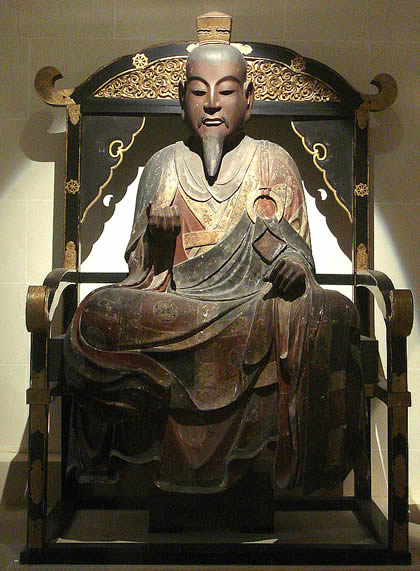 |
| Turkey flag |
Present-day Turkey lies in southeastern Europe and southwestern Asia and shares borders with Greece, Bulgaria, Armenia, Azerbaijan, Georgia, Iran, Iraq, and Syria. It is made up of 780,580 square kilometers. It contains the Bosporus Strait, which connects, the Black and Marmara seas, and is one of the busiest shipping lanes, in the world. Turkey also has coastline on the Aegean and Mediterranean seas.
Turkey has 81 provinces, and Ankara is the capital city. Turkey’s population is almost 70 million, of which a majority are Turkish, with a significant minority of Kurds, as well as Armenians, Greeks, Jews, Circassians, Assyrians, Arabs, and Laz communities. Turkey is overwhelmingly Muslim.
Turkey is a republican parliamentary democracy with a civil law system derived from several European legal systems such as the Swiss Code. The legislative branch is the unicameral Grand National Assembly, which contains 550 popularly elected seats.
Turkey’s economy is a mix of industrial, agricultural, and commercial. The private sector is expanding, but the state still controls most basic industries and the banking, transport, and communication sectors. The main export industries are textile and clothing production, with automotive and electronic export production close behind.
The main agricultural products include tobacco, cotton, grains, olives, sugar beets, pulses, citrus products, and livestock. In the 1990s Turkey’s economy suffered severe fluctuations, which culminated in financial disaster in February 2001. The International Monetary Fund (IMF) provides heavy backing, but the economy faces high debt and deficits.
Ismet Inönü took over as president upon the death of Mustafa Kemal Atatürk in 1938, and the Republican People’s Party (RPP) held the majority until 1950. Inönü managed to stay out of World War II until 1945, when Turkey declared war on Germany as a symbolic gesture in order to qualify as a founder of the newly forming United Nations. Under the Truman Doctrine, Turkey, due to its close proximity to the Soviet Union, qualified for massive financial aid.
Despite these achievements, the economy was weak, and the RPP and Inönü grew increasingly unpopular. Turkey had by then formed a multiparty system, and in 1950 the Democratic Party (Demokrati Partisi, or DP) received the majority in the elections, forcing the RPP to relinquish its 27-year majority.
 |
| Turkey map |
Celal Bayar became president, and Adnan Menderes became prime minister. The economic boom of the early 1950s strengthened Menderes and the DP’s position. By 1952 Turkey had become a member of the North Atlantic Treaty Organization (NATO), largely due to the fact that Turkey had immediately volunteered troops for the Korean War. Turkey’s entry into NATO ensured protection along its borders and allowed NATO a closer position against the USSR.
After the 1954 elections the DP became more authoritarian. Conflict was exacerbated when a Greek citizen placed a bomb at the Turkish consulate in Thessalonica. The island of Cyprus, under British control and with an 80 percent Greek majority, also became a point of conflict. These two issues culminated in riots in 1955 that targeted Greek homes, shops, and businesses and wrought havoc throughout Istanbul.
Many Turkish citizens of Greek origin fled Turkey after these riots. During this period, Greek nationalists of the EOKA movement on Cyprus also began a struggle against the British forces. Turkey strongly opposed British suggestions that the Greeks might be allowed to annex Cyprus. Ultimately Cyprus became an independent nation.
 |
| Turkey prime minister in 1950s, Adnan Menderes |
The DP lacked the support of the military, which had been vital to the RPP. This led to the DP’s downfall in 1960. Because of training, aid, and financial support gained as a result of joining NATO, the Turkish military was a strong and powerful mechanism within Turkey. Menderes grew increasingly unpopular with the military.
In 1960, the military overthrew the Menderes government. The coup was popular among students, who had been repressed by the DP. A new constitution was drawn up that justified military intervention if the ruling government acted unconstitutionally. The military was also given a role in government.
In January 1961 political activity was allowed once again, and 11 parties registered for the elections to be held at the end of 1961. One of the parties, the Justice Party (Adalet Partisi, or JP) appeared to be a phoenix of the old, outlawed DP. Menderes and two of his cabinet members were tried by a military tribunal and executed in September 1961. Elections were held in October 1961.
 |
| Süleyman Demirel |
The Justice and Republican People’s Parties formed a shaky coalition. In 1965 the JP, led by Süleyman Demirel, won a major victory in elections. Under Demirel, Turkey saw significant economic growth. The JP espoused Islamist and traditional beliefs that ran directly counter to communist and leftist thought. The left grew increasingly popular among the student population and industrial proletariat.
The right also emerged as a strong force in the 1960s, setting the stage for the crisis of the 1970s. The formation of two strong, Islamic-leaning parties, the National Action Party (Milliyetçi Hareket Partisi) and the National Order Party (Millî Nizam Partisi), seriously threatened the JP’s hold on the government in 1969.
Demirel’s JP government started to fall apart in 1971. On March 12, 1971, the army forced the Demirel government from office.
Free elections were held in 1973, with a victory by Bülent Ecevit’s RPP. However, because they failed to capture the majority vote, they were forced into coalition governments. This continued throughout the 1970s as rightist and leftist violence escalated. Kurdish separatism also flared up in the 1970s. Kurdish nationalist Abdullah Öcalan formed the left-leaning Kurdistan Worker’s Party (PKK) in 1978.
The sectarian violence escalated, and the military stepped in. After the Iranian revolution in 1979, Islamic groups in Turkey were suspected of receiving aid from Iran. The religious demonstrations in Konya in September 1980 provided an excuse for direct military intervention.
The Purge
 |
| Kenan Evren : president of turkey 1980-1989 |
The military suspended all political parties and groups and instituted martial law and curfews. General Kenan Evren was declared acting head of state. The National Security Council (NSC) arrested 122,000 people during 1980–81 in order to stop the violence. Academics and politicians were purged from the system. A new constitution was enacted in 1982. Kenan Evren was then elected president, and the military began to restructure the political system.
Elections were held in 1983, with the Motherland Party (Anavatan Partisi) gaining the majority under Turgut Özal. The old parties then reincarnated and changed their names in order to enter the 1984 elections. After Kenan Evren’s term ended in 1989, Turgut Özal became president. Turgut Özal’s presidency, although fraught with corruption and scandal, was also marked by impressive modernization.
 |
| Turgut Özal : President of Turkey 1989-1993 |
The 1990s were also marked by the rise of the PKK. After the 1980 coup the Kurdish language was forbidden, as was the term Kurdish as a separate identity. Abdullah Öcalan had fled to Damascus after the 1980 coup. Turkey until 1991 refused to acknowledge the presence of Kurds in the country and referred to them as "mountain Turks". The government forbade their language, songs, customs, and names.
Öcalan’s followers carried out their missions with an almost religious zeal. Talabani of the Kurdish PUK faction based in Iran helped Öcalan get financial support from Kurds living throughout the Middle East, which brought the PKK beyond the sphere of Turkey. The PKK also received support from Kurds living in Europe.
The PKK used guerrilla warfare to launch attacks within Turkey. The Turkish army responded brutally to the terrorist attacks. Villages thought to be harboring PKK terrorists were destroyed, and thousands were arrested, detained, and tortured. Many innocent people were killed and their homes destroyed.
After the U.S. defeat of Iraq in 1991, Turkey feared the creation of a Kurdish state in northern Iraq that would be used as a base for Kurdish attacks on Turkey. Subsequently, President Özal officially recognized the existence of Kurds in Turkey and implemented a bill that would allow the Kurdish language to be used in everyday conversations but not in business, government, or any other official agency.
Despite this, the PKK stepped up their campaigns against the Turkish government, committing more atrocities, which further enraged the Turkish public. Öcalan was captured in Nairobi, Kenya, by Turkish commandos in 1999. He was sentenced to death and imprisoned on an island in the Marmara Sea, where he remained for years.
 |
| Tansu çiller : first female prime minister of Turkey 1993-1996 |
In 1993 the True Path Party came into power, and Tansu çiller became the first female prime minister of Turkey. Necmettin Erbakan was the leader of Refah, which was supported by the young, professional middle class and students. Erbakan did not engage in a radical Islamic changeover.
He personally championed reforms to change the working hours during bulan pahala and loosen control of the Directorate of Religious Affairs to make it harder for the government to monitor Islam. Erbakan also proposed lifting the ban against wearing headscarves in universities and government institutions. The Erbakan/çiller coalition also made significant overtures to Libya and Iran, and at the same time condemned Israel.
With the advent of new freedoms under Erbakan, many other Islamic leaders eagerly expressed their long-silent opinions. Refah wanted to abolish the Swiss legal code instituted by Atatürk, and secularists feared a return to sharia, or Islamic law.
 |
| Recep Tayyip Erdogan : Prime minister of Turkey 2003-2014, Present days president of Turkey |
Erbakan and çiller both left government, and in 1998 the Constitutional Court formally disbanded Refah and forced its members out of Parliament. Bülent Ecevit emerged as the new president, in large part because of his handling of Öcalan and the Kurdish conflict. In 1999 a huge earthquake struck Izmit, near Istanbul, killing between 15,000 and 40,000 people.
The government was extremely slow to respond, and the public was enraged by the lack of support from both the government and the military. Memories of the earthquake played a role the emergence of the Justice and Development Party (JDP, or Ak Partisi). In the 2002 elections the JDP, led by Recep Tayyip Erdogan, won a majority in the Grand National Assembly.
Although the JDP espoused a moderate Islamic line, it was careful to respect the secular state. Erdogan also instituted reforms to help pull Turkey out of its financial troubles. Erdogan and the JDP also scored a major victory with the October 2005 decision by the European Union (EU) to start Turkey’s EU membership bid.
 |
| Present days Istanbul, Turkey |











